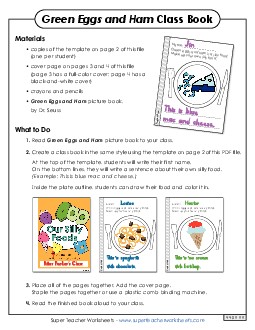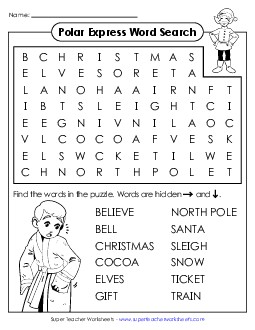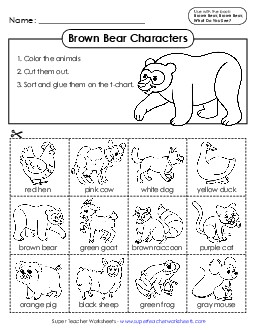Picture Book Literacy Units

In this classic story by Bill Martin Jr. and Eric Carle, students will read and see colorful animals, including a brown bear, a red bird, a yellow duck, a blue horse, a green frog, a purple cat, a white dog, a black sheep, and a goldfish.
Green Eggs and HamIn this rhyming story, Dr. Seuss challenges his readers to try a new food. Do you like green eggs and ham? Would you eat them in a box, or with a fox? Would you eat them in a house, or with a mouse?
If You Give a Mouse a CookieIf you give a little mouse a cookie, he's going to want a glass of milk. When you give him milk, he's going to want a straw. If you give him the straw, he's going to want a napkin. This adorable story circles around back to giving the mouse a cookie. Written by Laura Numeroff. Illustrated by Felicia Bond.
One Fish, Two Fish, Red Fish, Blue FishIn classic Dr. Seuss story, One Fish, Two Fish, Red Fish, Blue Fish, students will learn to read basic sight words and have fun with silly rhymes.
Polar Bear, Polar Bear, What Do You Hear?This is Bill Martin and Eric Carle's sequel to Brown Bear, Brown Bear, What Do You See? As you progress through the story students will learn about the many unique sounds that zoo animals make.
The MittenThis engaging story by Jan Brett is the perfect book to share with your class this winter season. Our worksheets include class projects, matching activities, trace and write exercises, and more.
The Polar ExpressThis holiday classic by Chris Van Allsburg tells the story of a boy who takes a ride on a magical train to the North Pole. Through his journey, he learns what it means to believe.
The Very Hungry CaterpillarThe little caterpillar in this story keeps eating and eating. He eats an apple, pears, plums, oranges, strawberries and more. Use these worksheets to supplement your reading of Eric Carle's classic book, The Very Hungry Caterpillar.
Dr. Seuss WorksheetsThis page has a variety of fun worksheets for celebrating Dr. Seuss' birthday on March 2nd.
Chapter Book Literacy UnitsThis page has units for dozens of popular chapter books. Titles include Charlotte's Web, Magic Treehouse, Junie B. Jones, Freckle Juice, Tales of a 4th Grade Nothing, Boxcar Children, and many more.



Picture books are an essential resource in elementary school English Language Arts (ELA) classrooms, helping young students develop early literacy skills while fostering a love for reading. Some popular children’s picture books like "Where the Wild Things Are" by Maurice Sendak, "The Very Hungry Caterpillar" by Eric Carle, and "Goodnight Moon" by Margaret Wise Brown are widely used to introduce young readers to storytelling, vocabulary, and visual literacy. These books, with their engaging illustrations and simple narratives, are especially helpful for kindergarten through second-grade students as they begin learning to read. By combining both pictures and words, picture books provide context clues that support comprehension, helping children understand the story even if they are still developing their reading skills.
In the classroom, teachers use picture books in a variety of ways to enhance students’ learning. Read-aloud sessions are a common method, where students listen to the story while following along with the images. This helps improve listening comprehension and encourages active participation as students predict what will happen next or discuss their favorite parts of the story. Teachers also use picture books as springboards for classroom activities like drawing, writing prompts, or discussions about the book’s theme or characters. For example, after reading "The Very Hungry Caterpillar," students might engage in an art project or a sequencing activity to reinforce the storyline and develop their ability to retell a narrative in order.
Picture books are valuable across various elementary grade levels, though they are particularly prevalent in early childhood education (K-2) as students are learning the fundamentals of reading. However, picture books can also be used in later grades (up to third or fourth grade) to teach more complex concepts like character development, plot structure, and moral lessons. The combination of visual and textual elements makes these books a powerful tool for building early literacy and comprehension skills. Super Teacher Worksheets offers free worksheets and activities for a variety of early reading books, and starting children on picture books at a young age lays a strong foundation for more advanced reading as they grow, helping them develop critical thinking, imagination, and a lifelong love of reading.






